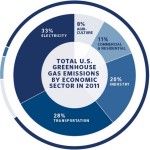On Tuesday, 25 June 2013, the President of the United States described his Climate Action Plan in a major policy address in Washington, DC. Later that day, the White House released the 21-page written plan. President Obama repeated his pledge from 2009, for the US to reduce greenhouse gas emissions by 17% below 2005 levels by 2020. While acknowledging that carbon dioxide levels in 2012 were the lowest in two decades, the President indicated that much more is to be done.

Three key pillars underpin the action plan:
-
Cut carbon emissions in the United States.
-
Prepare for the impacts of climate change.
-
Lead international efforts to mitigate and adapt to climate change.
-
Deploy clean energy by reducing emissions from power plants; promote renewable energy and investing in clean energy innovation.
-
Create a modern transportation system by increasing vehicle fuel efficiency standards, particularly for heavy-duty vehicles, encouraging biofuels through the Renewable Fuel Standard; and support advanced battery and fuel cell technology.
-
Improve energy efficiency by establishing new energy efficiency standards for buildings and appliances; reduce barriers to investments in efficiency; and cut energy consumption in commercial and industry buildings.
-
Reduce other greenhouse gas emissions, specifically hydro fluorocarbons and methane. Also preserve the role of forests in mitigating climate change.
-
Improve energy efficiency in U.S. government buildings and operations.
-
Encourage resilient infrastructure by removing investment barriers; support state and local preparedness; develop new guidelines for buildings and other infrastructure; and learn from experiences with Superstorm Sandy.
-
Protect critical assets, including power plants, fuel distribution facilities, hospitals and other healthcare facilities; maintain sustainable agriculture; reduce wildfires and droughts; and prepare for floods.
-
Manage impacts through sound science by better understanding the impact of climate change; leverage government climate data to spur innovation; and create a “toolkit” to access resources.
“The energy sector is impacted whereas other sources of greenhouse gas emissions are ignored. The President’s plan is consistent with US law as determined by the Supreme Court.
The Environmental Protection Agency is compelled to regulate CO2 emissions. Eventually, every fossil fuel power plant will have to have carbon capture and storage. That is, every new and existing coal plant and every new and existing natural gas plant.
The important question is the timing and the flexibility of the regulations. If the rules force CO2 reductions before carbon capture and storage technology is ready for widespread deployment, premature closure of existing plants is likely and no new plants may be built. The impact on the economy, on jobs and on electricity prices will largely depend on the flexibility embedded in the EPA rules.”
In terms of leading international efforts, the President pledged to enhance and expand existing initiatives, such as the Major Economies Forum on Energy and Climate; the Carbon Sequestration Leadership Forum; the Unconventional Gas Technical Engagement Program; the Climate and Clean Air Coalition to Reduce Short-Lived Climate Pollution; and the US–Asia Pacific Comprehensive Energy Partnership, among others.
In addition, President Obama committed to expanding bi-lateral cooperation with China, India, and Brazil. The President also committed to invest in capacity development in developing countries to further their ability to adapt to climate change.
Much of the implementation of the President’s Climate Action Plan will be accomplished through federal agencies operating under existing legislative authority. No new congressional action is anticipated.
Details on the plan are available at www.WhiteHouse.gov





